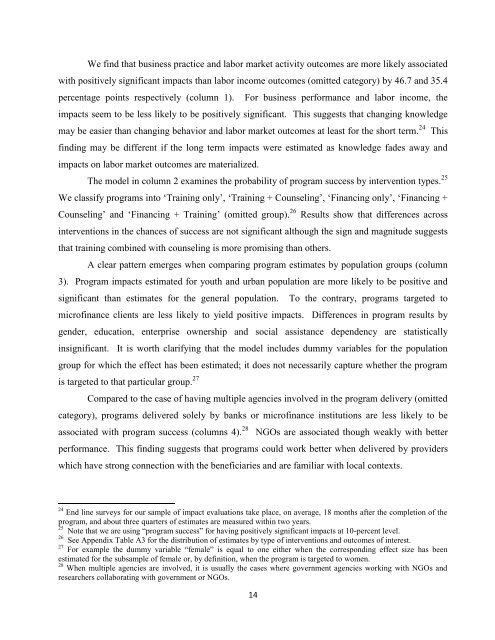Entrepreneurship Programs in Developing Countries: A ... - IYFLive.net
Entrepreneurship Programs in Developing Countries: A ... - IYFLive.net
Entrepreneurship Programs in Developing Countries: A ... - IYFLive.net
Create successful ePaper yourself
Turn your PDF publications into a flip-book with our unique Google optimized e-Paper software.
We f<strong>in</strong>d that bus<strong>in</strong>ess practice and labor market activity outcomes are more likely associatedwith positively significant impacts than labor <strong>in</strong>come outcomes (omitted category) by 46.7 and 35.4percentage po<strong>in</strong>ts respectively (column 1). For bus<strong>in</strong>ess performance and labor <strong>in</strong>come, theimpacts seem to be less likely to be positively significant. This suggests that chang<strong>in</strong>g knowledgemay be easier than chang<strong>in</strong>g behavior and labor market outcomes at least for the short term. 24 Thisf<strong>in</strong>d<strong>in</strong>g may be different if the long term impacts were estimated as knowledge fades away andimpacts on labor market outcomes are materialized.The model <strong>in</strong> column 2 exam<strong>in</strong>es the probability of program success by <strong>in</strong>tervention types. 25We classify programs <strong>in</strong>to ‘Tra<strong>in</strong><strong>in</strong>g only’, ‘Tra<strong>in</strong><strong>in</strong>g + Counsel<strong>in</strong>g’, ‘F<strong>in</strong>anc<strong>in</strong>g only’, ‘F<strong>in</strong>anc<strong>in</strong>g +Counsel<strong>in</strong>g’ and ‘F<strong>in</strong>anc<strong>in</strong>g + Tra<strong>in</strong><strong>in</strong>g’ (omitted group). 26 Results show that differences across<strong>in</strong>terventions <strong>in</strong> the chances of success are not significant although the sign and magnitude suggeststhat tra<strong>in</strong><strong>in</strong>g comb<strong>in</strong>ed with counsel<strong>in</strong>g is more promis<strong>in</strong>g than others.A clear pattern emerges when compar<strong>in</strong>g program estimates by population groups (column3). Program impacts estimated for youth and urban population are more likely to be positive andsignificant than estimates for the general population. To the contrary, programs targeted tomicrof<strong>in</strong>ance clients are less likely to yield positive impacts. Differences <strong>in</strong> program results bygender, education, enterprise ownership and social assistance dependency are statistically<strong>in</strong>significant. It is worth clarify<strong>in</strong>g that the model <strong>in</strong>cludes dummy variables for the populationgroup for which the effect has been estimated; it does not necessarily capture whether the programis targeted to that particular group. 27Compared to the case of hav<strong>in</strong>g multiple agencies <strong>in</strong>volved <strong>in</strong> the program delivery (omittedcategory), programs delivered solely by banks or microf<strong>in</strong>ance <strong>in</strong>stitutions are less likely to beassociated with program success (columns 4). 28 NGOs are associated though weakly with betterperformance. This f<strong>in</strong>d<strong>in</strong>g suggests that programs could work better when delivered by providerswhich have strong connection with the beneficiaries and are familiar with local contexts.24 End l<strong>in</strong>e surveys for our sample of impact evaluations take place, on average, 18 months after the completion of theprogram, and about three quarters of estimates are measured with<strong>in</strong> two years.25 Note that we are us<strong>in</strong>g “program success” for hav<strong>in</strong>g positively significant impacts at 10-percent level.26 See Appendix Table A3 for the distribution of estimates by type of <strong>in</strong>terventions and outcomes of <strong>in</strong>terest.27 For example the dummy variable “female” is equal to one either when the correspond<strong>in</strong>g effect size has beenestimated for the subsample of female or, by def<strong>in</strong>ition, when the program is targeted to women.28 When multiple agencies are <strong>in</strong>volved, it is usually the cases where government agencies work<strong>in</strong>g with NGOs andresearchers collaborat<strong>in</strong>g with government or NGOs.14
















